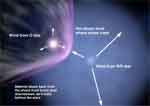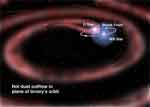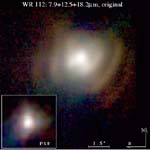
 Medium-res JPEG (46k) High-res JPEG (365k) High-res TIFF (9,122k)
|
This artist’s rendering shows a close-up view of what is believed to be happening at the “Shock-Zone” where the stellar wind from the Wolf-Rayet star collides with the weaker stellar wind from the less-evolved normal “O-type” star in the WR112 binary system. The Shock-Zone is where the larger carbon based dust particles are thought to be produced. Ultimately it is estimated that about 20% of the dust is expelled into the interstellar medium. Artwork by Jon Lomberg. This image must be credited to "Gemini Observatory". |
 Medium-res JPEG (44k) High-res JPEG (216k) High-res TIFF (9,236k) |
This illustration shows the formation of the dust spiral that is likened to a “playful gardener swinging around a high-pressure garden hose”, although without gravity pulling the water to the ground. This process is powered by the interaction between the stellar winds of each star, combined with the orbital motion of the two massive stars around each other. Artwork by Jon Lomberg.
This image must be credited to "Gemini Observatory". |
 Medium-res JPEG (67k) High-res JPEG (368k) High-res TIFF (12,312k) |
This illustration is based upon “deconvolved” Gemini data of the WR112 system at 18.2 microns. The gray spiral is the theoretical model prediction of how the dust should be distributed and the actual data is shown in red. The close match between the theory and observation leads to a high degree of confidence in our understanding of this system. Artwork by Jon Lomberg.
This image must be credited to "Gemini Observatory". |
 Full-res JPEG (51k) |
This “color” image was produced by combining the three mid-infrared data images of WR112 from the Gemini observations at wavelengths of 7.9, 12.5 and 18.2 microns as blue, green and red respectively. In addition to the visible but periodically interrupted spiral structure, a reddening of the light can be seen toward the edges indicating the cooler dust that may be escaping from the system.
This image must be credited to "Gemini Observatory". |
Peter Michaud / pmichaud@gemini.edu / February 22, 2002